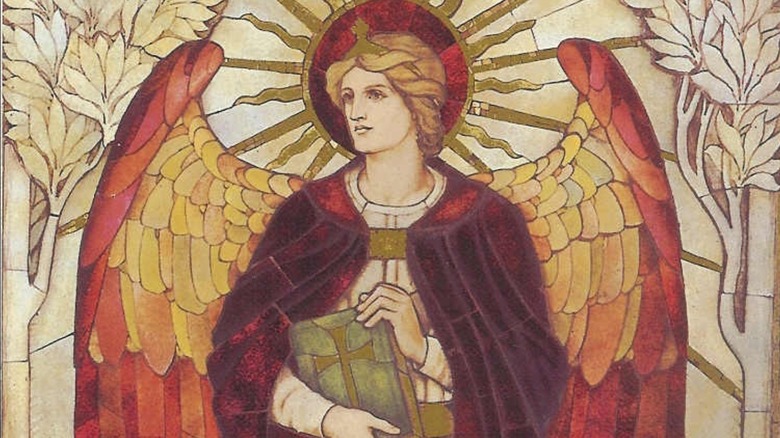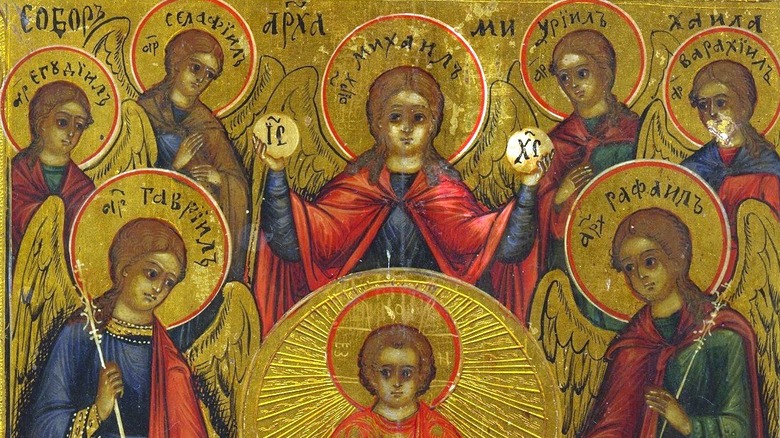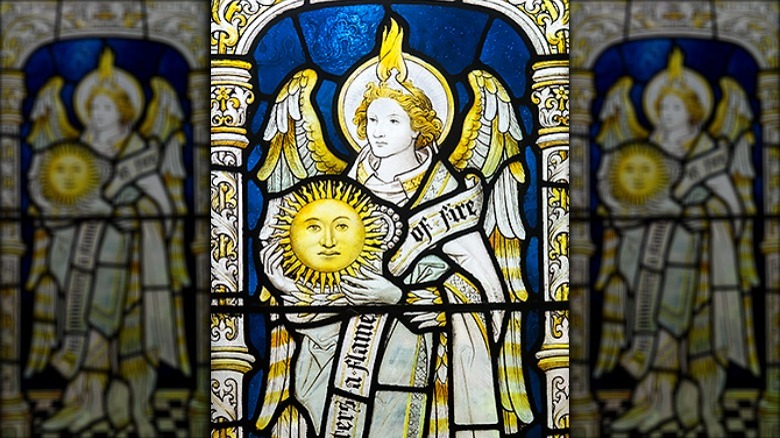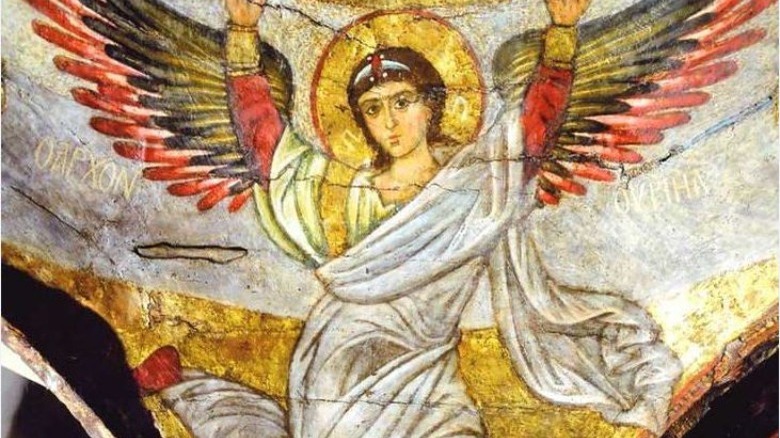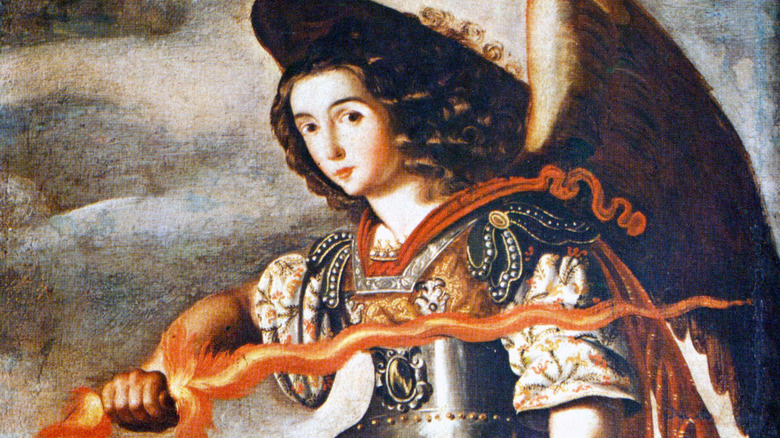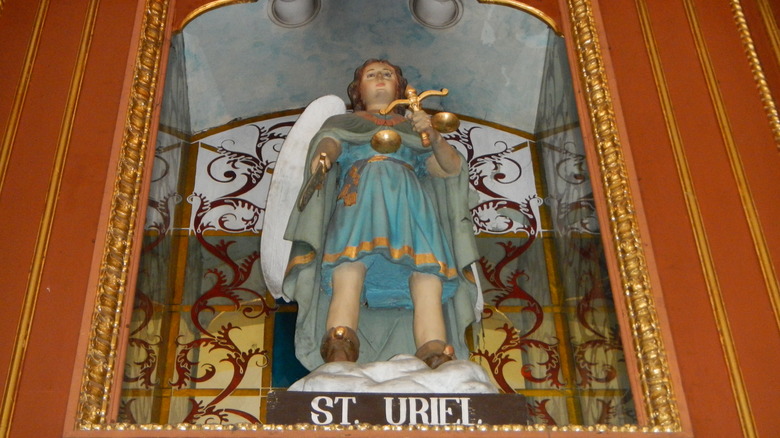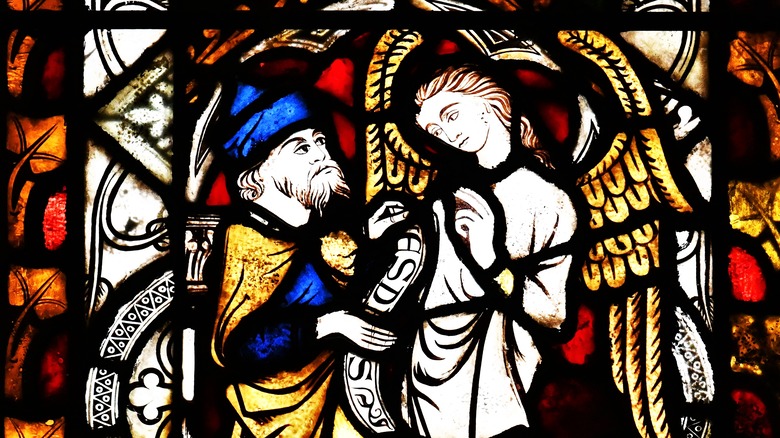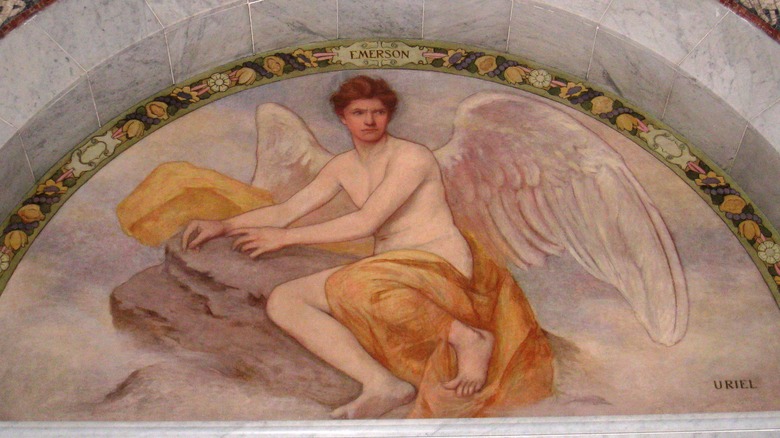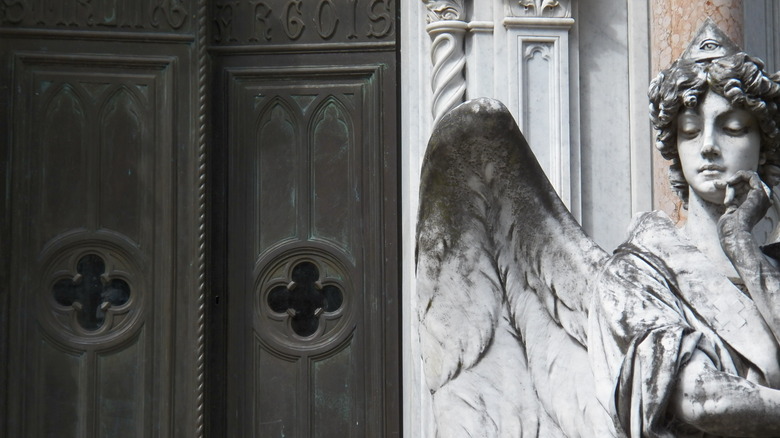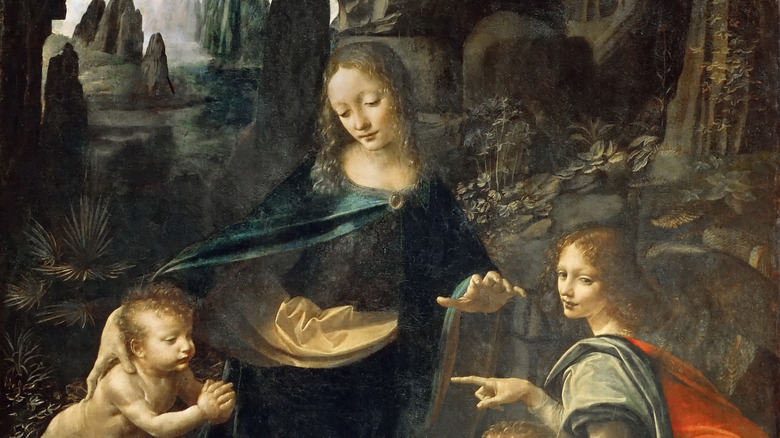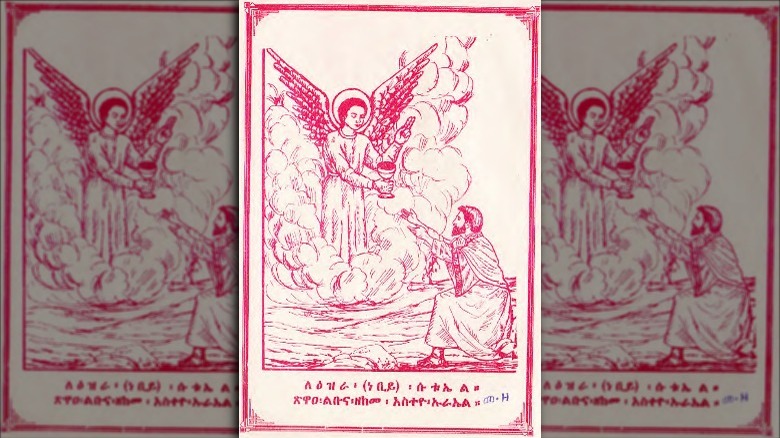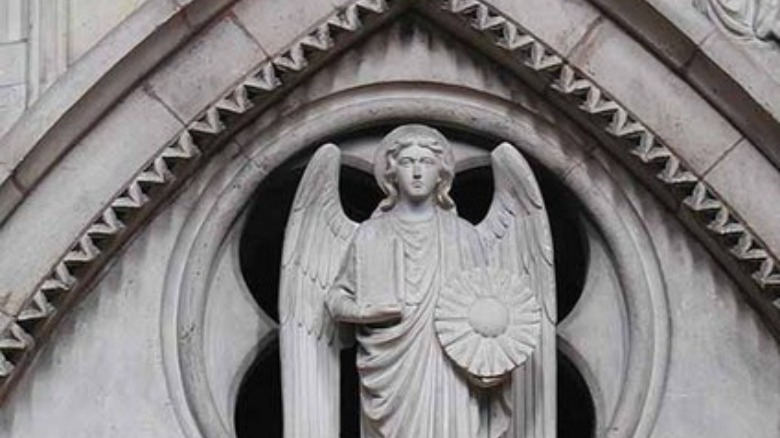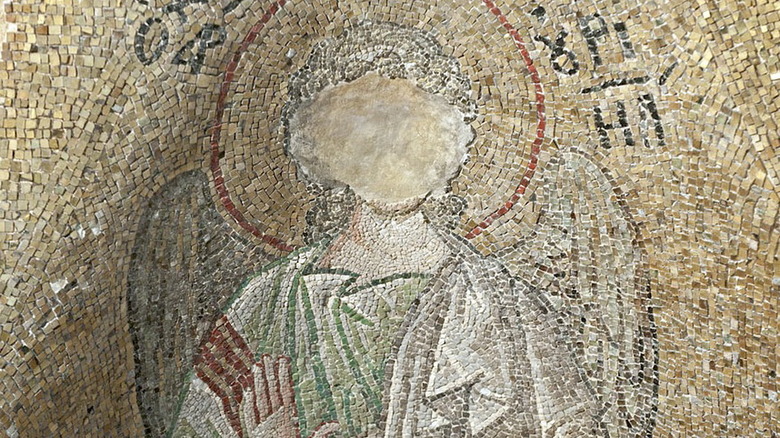The Archangel Uriel: The Untold Truth
Everybody knows angels. Whether it's in Renaissance paintings or political cartoons of recently deceased celebrities, the popular depiction of God's immortal messengers as androgynous figures in white robes with fluffy white wings and halos is nearly ubiquitous, although the recent surge of "biblically accurate angel" memes threatens to overtake it. Either way, angels are indelible images of Christianity, but we still know relatively little about them. How many can you even name? Gabriel? Michael? Lucifer, if you've read more of Milton than the Bible?
One angel that doesn't come up in most churches' canonical scriptures that nevertheless plays a big role in religious literature is Uriel, the fourth archangel. Though not given big roles like announcing the birth of Christ or throwing Satan into a big hole, Uriel has still managed to be attached to a number of significant events and jobs. If you think Satan is the one in charge of Hell, read on to learn about Uriel Hell-Keeper.
Uriel is a big deal, but doesn't appear in most Bibles
Despite angels having a fairly outsized presence in popular understanding of Christianity (and to a lesser degree, Judaism), the Bible actually has relatively little to say about the specifics regarding these spiritual denizens of Heaven. As the Saint Catherine of Siena Roman Catholic Church points out, the only angels given names in canonical scripture are Gabriel, Michael, and Raphael. And of these, Gabriel and Michael are the only ones to appear in books considered canon by Jewish and Protestant churches; Raphael appears in the Book of Tobit, a later era Jewish text that is canonical in the Catholic and Orthodox Churches, but not others. However, it is very common to see four archangels grouped together (why four? The Jewish Encyclopedia explains that this represents the four cardinal directions), the fourth is almost always Uriel.
While not appearing in the primary canon, Uriel does appear in a number of books that are generally regarded as apocryphal. For example, the First Book of Enoch–which is canon for the Ethiopian Orthodox Church, and which is quoted in the New Testament Epistle of Jude–has a lot to say about angels, and Uriel is specifically listed there as one of seven archangels. Likewise, the book called 2 Esdras (confusingly sometimes also called 4 Esdras)–which is also considered canon by the Ethiopian Church–features Uriel as an important figure. A number of other apocryphal and mystical texts include Uriel as well.
An angel by any other name
As Christianity.com explains, the name Uriel comes from a Hebrew word meaning "fire of God." This is commonly explained as being related to a word meaning "light of God" or "God is my light," but the Jewish Encyclopedia says that this connection is actually a false etymology. As with any name that is transliterated from Hebrew into Greek, Latin, Ethiopian, or any other language and then into English, it is common to find alternative spellings, so it's entirely likely that–as Learn Religions records–you might encounter Uriel in a text where his name is spelled Usiel, Uzziel, Oriel, Auriel, Suriel, Urian, or Uryan.
When four archangels are listed, Uriel is usually the fourth (and almost always named last after the three that appear in more canonical texts), but that's not always the case. As the Jewish Encyclopedia explains, the fourth named archangel is sometimes Phanuel (also spelled Fanuel), Aniel, and the very similarly named Nuriel. As a result, Uriel is often conflated with these other angels. Within the primary text of Kabbalah called the Zohar, Uriel and Nuriel are seen as two aspects of the same angel. As the Jewish Virtual Library explains, Uriel represents the merciful aspect of the angel, while Nuriel is his "bad cop" side. The Zohar also connects Uriel, angel of fire, to the sacrifices made at the First Temple, whose altar it says was called Ariel after the angel.
Uriel brings the thunder
As an archangel, Uriel has a number of responsibilities and aspects, such as elements of the natural world that he presides over. Since his name means "fire of God," a lot of the things associated with Uriel stem from that connection. According to the Jewish Encyclopedia, Uriel is seen as the source of heat during the winter and is often connected with the sun, including being seen as presiding over Sunday, the first day of the week. He is also responsible for the positioning of the sun and constellations. Other natural phenomena attributed to Uriel include thunder and earthquakes. The major association between Uriel and fire is his role as the chief angel of Gehenna, the eternally burning fire pit that evolved into the Christian concept of Hell. He is, of course, also one of the four Angels of the Presence, the four angels that stand around the throne of God in the four cardinal directions. Uriel's direction varies from source to source, being variously north, west, or south.
Within Christianity, Uriel has a number of different roles as well. As Christianity.com explains, Uriel is known as the Prince of the Sun, the Patron of Prophecy, and the Archangel of Salvation, among others. In the Anglican Church and some Catholic churches, Uriel is viewed as the patron of the sacrament of confirmation, and the preserver of beauty and light.
Uriel, Prince of Hell
One of the main roles of Uriel through Jewish and Christian literature is his job as the chief among the angels of the afterlife, identified variously as Sheol (kind of a neutral storage tank for souls until the Day of Judgment), Gehenna (an eternally burning trash heap of the damned), or Hell (you've heard of this one). A key text for this is the apocryphal (but still very popular and influential) Christian book known as the Apocalypse of Peter, in which the Apostle Peter receives incredibly messed up visions of Heaven and Hell, including babies that shoot eye lasers and monsters made of breast milk. In this work, Uriel is an angel of repentance, whose job is to set punishments upon sinners for their misdeeds in life. He is specifically described as setting idolaters in everlasting fire and placing those who are judged to be unrighteous into a flowing river of flame. And perhaps in the most metal moment of all, Uriel's job at the Day of Judgment is to smash down the bronze gates of the grave and resurrect the giants killed in Noah's flood so they can stand trial for their transgressions.
In this role, he is given the title of Tartaruchus, or Hell-Keeper, which in a truly implausible but totally true etymology is the likely source of the modern English words turtle and tortoise.
Uriel versus the fallen angels
The mostly-but-not-entirely apocryphal Book of Enoch expands on the story of the titular Enoch, Noah's great-grandfather who God thought was so cool that he brought him up to Heaven to hang out instead of letting him die. It also features a lot more angels than the primary biblical canon, with much of the plot focused on fallen angels who corrupted humanity by teaching them forbidden arts after having sex with human women and spawning a race of evil giants that basically ruined the world. Consequently, there are a number of good angels that populate the text as well, showing God's power in opposing the forces of the evil ones. Uriel, as is so commonly the case, is named as one of the main angels along with Michael, Gabriel, and Raphael.
In the early portions of the book, in which God is planning to issue judgment on all humankind (which he eventually does with a big flood; you might have heard of it), Uriel and the other three archangels are the ones who intercede on behalf of the humans and ask God not to wipe out humanity entirely. As a result, Uriel is the angel sent by God to warn Noah of the impending flood. Uriel, who is again mentioned in his role as Hell-Keeper, oversees the punishments of the fallen angels and also serves as Enoch's guide through the afterlife.
Uriel and the question of evil
The book known as 2 Esdras is also sometimes called 4 Esdras depending on who's counting. "Esdras" is the Greek form of the name of the Hebrew priest Ezra, so some churches count the fully canonical books of Ezra and Nehemiah as 1 and 2 Esdras, making the two books after that 3 and 4 Esdras, though other churches call them 1 and 2 Esdras. Make sense? No? That's fine, it's actually more complicated than that anyway. But 1 (or 3) Esdras is canon among Eastern Orthodox and Oriental Orthodox churches, while 2 (or 4) Esdras is only canon among some Oriental Orthodox churches, including the Ethiopian Orthodox Church, which seems to be open to pretty much anything.
Anyway, the key thing here is that Uriel is in it. In chapter 4 of the text, Ezra has a vision of the archangel while the Jews are still in captivity in Babylon. Ezra had asked how the Jews' suffering jibes with God's justice and mercy. Uriel is sent to help answer that question, but unfortunately the answer is the same largely unsatisfying one given in the Book of Job: namely, that God's plans are too vast for puny human brains to understand. Unless, as Uriel says, we can weigh fire or measure the wind or travel through time, maybe we should just stop complaining.
Uriel buries Adam, literally
The Life of Adam and Eve, also known in one version as the Apocalypse of Moses, is a collection of mostly similar but frequently different writings that exist in a number of different languages, including Latin, Greek, and Slavonic, that greatly expands on what happened to Adam and Eve and their children after they were kicked out of the Garden of Eden.
In the Latin version of the story, Eve has a vision that her son Cain will drink the blood of her other son Abel, and so she makes Cain a farmer and Abel a herdsman, not knowing that this decision will ultimately cause Cain's murder of Abel. Adam and Eve have a new son, Seth, who is described as taking Abel's place as the good son in the family. Years later, when Adam is dying at the age of 930, he sends Seth back to the Garden of Eden to seek out an oil from a tree there that might heal him. Seth goes to the Garden and does battle with the serpent (yes, that serpent), only to be sent away without the oil by the archangel Michael. Adam consequently dies and is taken up to Heaven, and there is a joint funeral for him and his long-dead son Abel, which is overseen by Michael and Uriel, who bury them in a hidden corner of the Garden of Eden.
A host of Uriel retcons
It's not only in apocryphal (or mostly apocryphal) literature that Uriel gets to play a role in biblical history. Thanks to the power of retcons, it turns out that Uriel was actually part of a lot of the Bible stuff you already know about, you just didn't know it was him who was there. The Saint Catherine of Siena Roman Catholic Church outlines some of the many well-known stories into which Uriel has been inserted by rabbis, commentators, and other authors and traditions: Uriel is said to be the cherub placed at the entrance to Eden to keep anyone from ever returning there, armed with an intimidating fiery sword (which fits his temperament and association with fire); he is the angel that led Abraham west from his birthplace of Ur to Canaan, which would become the Promised Land of his descendants, the Jews; he is also the angel whose job it was to check for lamb's blood on the doors of the homes of everyone in Egypt during the first Passover.
It is a historical fact that around 701 BCE the Assyrian king Sennacherib besieged the city of Jerusalem after having conquered the northern kingdom of Israel, but for reasons unknown, failed to take the southern kingdom as well. The Second Book of Kings says that an angel came and killed a staggering 185,000 Assyrian troops. Tradition assigns this mass slaughter to the hand of Uriel.
Uriel saves a baby
One of the most messed up parts of the Christmas story is what is known as the Massacre of the Innocents. According to the Catholic Encyclopedia, the Gospel of Matthew records King Herod becoming extremely upset when he learns that the Magi are seeking out a new King of the Jews. As a result, Herod decrees that all male children under the age of two in Bethlehem and the surrounding area should be killed, in hopes of snuffing out the infant Jesus. The baby Jesus only escapes execution when his family flees to Egypt. Not only is the mass infanticide (as many as 144,000 babies according to some truly implausible sources) a terrible thing to happen at all, it also creates something of a plot hole for the continuity of the Gospels: namely, if all babies in the area except Jesus were killed, how did his cousin John the Baptist, only six months older, survive to adulthood?
An early Christian text called the Gospel of James asserts that the baby John and his mother Elizabeth were protected by an angel that split a mountain in half so that they could escape through it. Later tradition assigns this role to Uriel, and it was a common motif in art–most famously in Leonardo's Virgin of the Rocks–to show Uriel bringing the baby Johnny Bapto to the Holy Family in Egypt.
Angel of fire, chalice of blood
Since the major texts concerning the archangel Uriel–namely the Book of Enoch and 2 Esdras–are considered canon only among the Ethiopian Orthodox Church, it stands to reason that this church would have more to say about Uriel than other churches. Consequently, in the 15th century a homily on the archangel Uriel was composed as part of a larger collection of homilies about angels. This homily collects various miracles and actions performed by the archangel to aid in the veneration of him. Naturally much of the text focuses on the stories from Enoch and Esdras, in which Uriel serves as a helper, guide, and interpreter of prophecies to both of those esteemed men, but the homily expands on these themes.
Popular Ethiopian tradition says that at the crucifixion, Uriel dipped his wing in the blood and water that flowed from Jesus's side and wrung it out in a chalice that he carried to Ethiopia. He used this blood to sanctify locations for churches there and make a "safe haven for the Holy Grail." One Ethiopian text explains that an emperor arrived in a new country that Uriel had sanctified with the Lord's blood and built three churches: one for Jesus, one for the Virgin Mary, and one for the one who had made it all possible, the archangel Uriel. As a result, Uriel is often depicted in Ethiopian art holding a chalice full of blood.
Angel of Mars
In 1851, the famous American poet Henry Wadsworth Longfellow wrote a poem called The Golden Legend that is unrelated to the 13th century collection of saints' lives, but is instead based on a medieval German poem called Der arme Heinrich ("Poor Henry"). The story centers on a Prince Henry who is being tested by Lucifer. He is given a deadly disease that can only be cured by the blood of a young woman who willingly sacrifices herself for him. There are many Satan-related shenanigans, and the cursed prince and a selfless young lady have some adventures, but in the midst of all this, the prince goes to church and sees a Nativity play that is being put on.
In this play, the angels that rule over the seven classical planets–that is to say, the five non-Earth planets that can be seen with the naked eye plus the sun and moon–all bear the Christmas star to Bethlehem. Raphael is the angel of the sun, Gabriel the moon, and Michael Mercury, while angels with names like Anael, Zobiachel, and Anachael are the angels of Venus, Jupiter, and Saturn. Uriel is the angel of Mars, "the strongest star among the stars!" He is credited with giving courage to soldiers as they march into battle both literal and figurative. This fits Uriel's depiction as a flaming sword-wielding slayer of hundreds of thousands.
When to celebrate Uriel
If you want to venerate the archangel Uriel in hopes of getting help in interpreting prophecy like Ezra, you have a couple of options for the appropriate day to do this depending on which church you want to go to. As the Saint Catherine of Siena Roman Catholic Church explains, in 745 Pope Zachary restricted the veneration of angels to those mentioned by name in the canonical Bible in order to try to keep popular devotion to angels on a leash. As a result, there's no official feast day for Uriel in the Roman Catholic Church, but you could maybe slip him in with your prayers to the archangels Michael, Gabriel, and Raphael on September 29, also known as Michaelmas. In the Anglican Church (also known as the Episcopal Church in the U.S.), where they venerate Uriel enough to name actual churches after him, Uriel is also celebrated on Michaelmas with the other archangels.
In the Eastern churches, Uriel is commemorated together with the other archangels as part of the "Sunaxis of the Archangel Michael and Other Bodiless Powers" on November 8. The book Angels A to Z attests that in the churches of Egypt and Ethiopia, where Uriel is held especially dear, the archangel is celebrated on July 28. Other sources cite July 11. So really, celebrate God's Hell-Keeper whenever you feel is appropriate.
